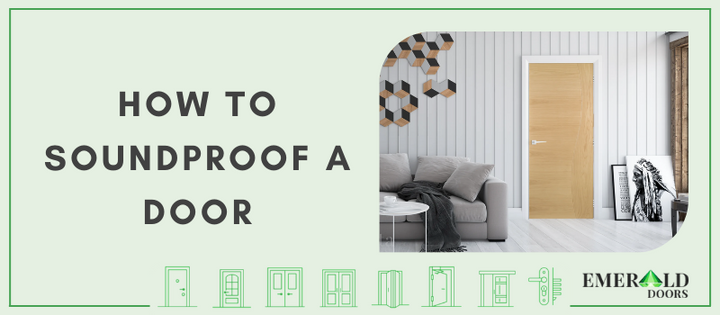
How to Soundproof a Door: A Complete Guide
If your home or office is located in high-traffic areas or busy streets, you are probably prone to noisy environments. And let’s be honest, who likes being in such an environment all day? Not me, for sure!
Excessive noise has a harmful effect on both your physical and mental health. Your sleep pattern gets disturbed, you become irritable and moody, and much more.
One solution to escape this noisy environment is to soundproof your doors and windows. This not only blocks external noise from entering your home or office, but also helps maintain privacy by stopping sound from bothering other people outside your room as well.
A soundproof door prevents sound and vibration from passing from one room to another. These soundproof doors are typically used in homes, offices, cinema theatres, nightclubs, recording studios, concert venues, and many such places.

(Product)
7 Methods to Soundproof a Door
To soundproof your doors, you can follow many methods, such as -
- Use weatherstripping on your door
- Add acoustic door sales
- Use door sweeps and bottom seals
- Soundproofing blankets or curtains
- Add a door gasket
- Use acoustic panels
- Install solid-core doors
Let us check out all the above-mentioned methods in detail.
-
Use Weatherstripping on Your Door
One of the simplest and most cost-effective ways to soundproof a door is by using weatherstripping. Weatherstrips are available in various materials, such as foam, rubber, or silicone, and can be easily attached to the door frame.
Start by cleaning the door frame to ensure proper adhesion, then measure and cut the weatherstripping to fit the sides and top of the door frame. This creates an airtight seal, reducing the passage of sound waves and drafts.
-
Add Acoustic Door Seals
Acoustic door seals, also known as door perimeter seals, are specifically designed to enhance soundproofing. They are typically made of a dense material like neoprene or silicone and are attached to the edges of the door. When the door closes, these seals create a tight seal between the door and the frame, effectively blocking sound from entering or leaving the room.
-
Use Door Sweeps and Bottom Seals
Sound can easily travel through the gap at the bottom of the door. However, this issue can be addressed effortlessly with door sweeps and bottom seals. Door sweeps are attached to the bottom of the door, on the inside, and are hung downwards to create a barrier.
Whereas bottom seals are fixed to the threshold of the door frame. Together, they ensure that the sound is less likely to leak through the gap at the door’s base.
-
Soundproofing Blankets or Curtains
If you are seeking a temporary or portable solution to noise cancellation, soundproofing blankets or curtains can be highly effective. These dense, noise-absorbing materials can be hung over the door, serving as a barrier to sound transmission.
Soundproof blankets are particularly useful in spaces where flexibility is required, such as studios, homes, or rented apartments, where permanent modifications are not allowed.
-
Add A Door Gasket
A door gasket is a specific seal that is fitted at the door’s perimeter. It creates an air-tight seal when the door is closed, preventing both noise and drafts from passing through the door. Door gaskets are easy to install and are a valuable addition to your soundproofing efforts.
-
Use Acoustic Panels
Acoustic door panels are a great option for soundproofing both doors and walls. These panels are designed to absorb sound waves and reduce the echo sound in a room. While they are commonly used on walls and ceilings, they can also be installed on doors. Acoustic door panels come in various sizes and styles, including decorative options that make acoustic door panels blend seamlessly with your home’s interior.
To install acoustic panels on a door, you can use adhesive hooks or mounting brackets. Place them strategically to cover as much surface area as needed for effective sound absorption. Keep in mind that acoustic panels not only block sound from entering or leaving the room but also improve the overall acoustics within the space.
-
Solid Core Doors
When all else fails, and you're looking for a long-term solution, consider replacing your existing door with a solid core door. Solid-core doors are heavier and denser than standard hollow-core doors, making them excellent at blocking sounds. The added mass of a solid core door helps reduce sound transmission significantly.
To install a solid core door, you'll likely need professional assistance, as it may involve resizing the door frame to accommodate the thicker door. However, investing in a solid core door can provide substantial and lasting soundproofing benefits.
Conclusion
Soundproofing a door is a crucial step in creating a peaceful and quiet environment. Whether you're dealing with noisy neighbors, a bustling home office, or a music studio, these effective methods are perfect to minimize sound transmission. Invest in good quality internal doors and external doors from Emerald Doors. With the right combination of these techniques, you can enjoy a quieter and more serene space tailored to your needs.
FAQs on How to Soundproof a Door
- Can you soundproof an existing door?
-
What is the best door to block sound?
-
Does covering the bottom of the door reduce noise?
Yes, covering air gaps at the bottom of a door with a draft stopper or door sweep can effectively reduce noise transmission. These seals help create a barrier that minimizes the passage of sound and drafts, improving the overall soundproofing of a room.